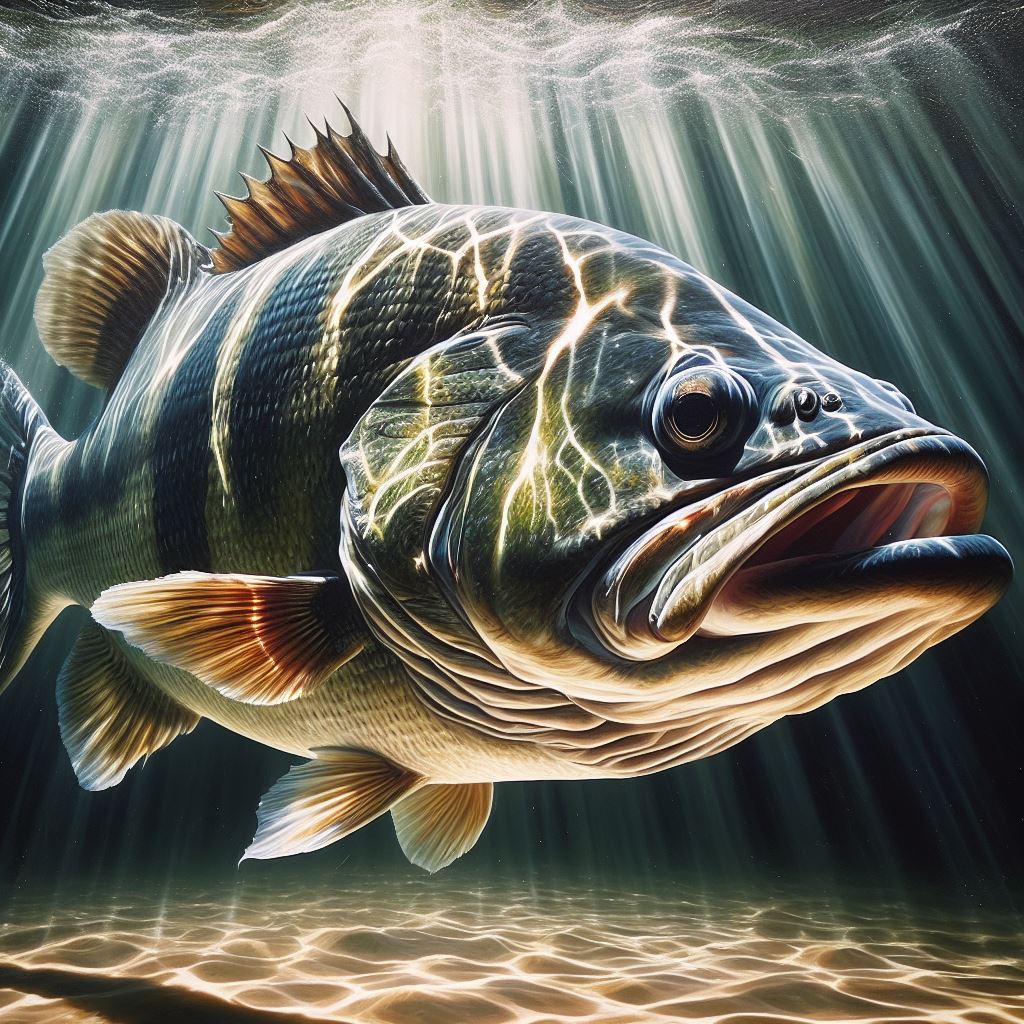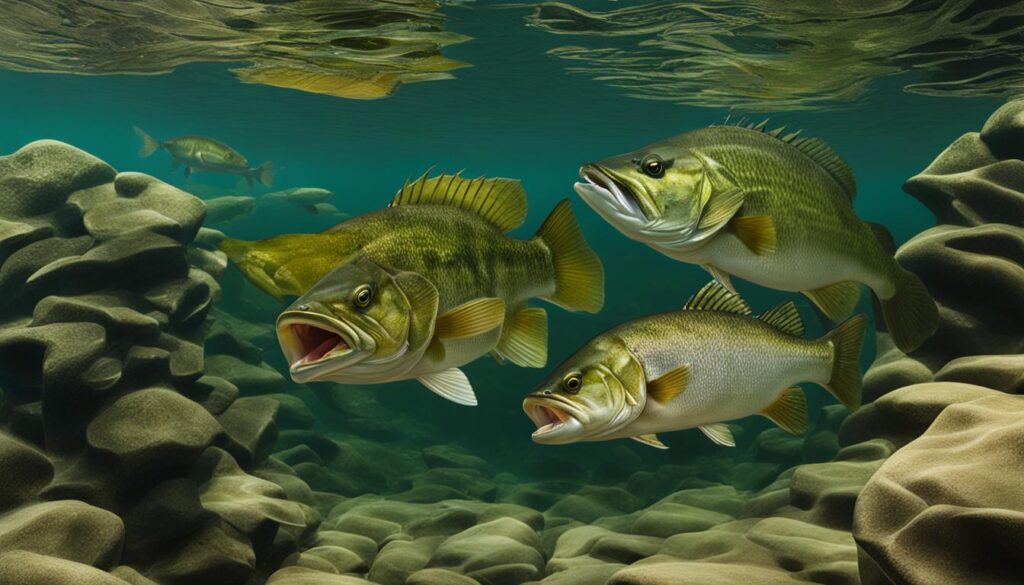
Smallmouth Bass vs Largemouth Bass: Key Differences Explained
On December 21, 2023 by fishingamericatoday StandardSmallmouth Bass and Largemouth Bass are two popular freshwater fish species in America. While they may have similarities in appearance and habitat, there are some key differences that distinguish them.
Largemouth Bass grow larger, with some reaching double the size of Smallmouth Bass. Additionally, Smallmouth Bass are often referred to as “Brown Bass” and Largemouth Bass as “Green Bass,” but both can exhibit varying colors.
The easiest way to tell them apart is by looking at their mouths and fins. Largemouth Bass have larger mouths and a break between their dorsal fins, while Smallmouth Bass have smaller mouths and uninterrupted dorsal fins.
In terms of behavior, Smallmouth Bass are more acrobatic and tend to jump more when hooked, while Largemouth Bass are less likely to jump. They also have different habitat preferences, with Smallmouth Bass preferring colder waters in northern regions and Largemouth Bass thriving in warmer southern lakes.
Characteristics of Smallmouth Bass and Largemouth Bass
Smallmouth Bass and Largemouth Bass are two distinct species with unique characteristics that differentiate them from each other. By understanding these differences, anglers can enhance their fishing strategies and increase their chances of success.
Appearance and Size
One of the primary differences between Smallmouth Bass and Largemouth Bass is their appearance. Smallmouth Bass have lighter colors and smaller jaws, earning them their name. They can grow between 12 and 18 inches and are native to North America. On the other hand, Largemouth Bass have larger jaws that extend past the eye. They are darker in color and can be found in green, black, or brown variations with horizontal lines along their bodies. Largemouth Bass are the largest fish in the sunfish family, growing between 16 and 24 inches.
Habitat Preferences
The habitat preferences of Smallmouth Bass and Largemouth Bass also differ. Smallmouth Bass are typically found in cold waters, such as lakes, ponds, and rivers in northern regions. They thrive in deep, clear, and cool waters, often found in rocky highland reservoirs, glacial lakes, and swift streams. On the other hand, Largemouth Bass prefer warmer southern lakes and ponds with abundant vegetation and cover. They are often found in areas with thick cover, such as weed beds, brush piles, and grasses.
Feeding Habits
The feeding habits of Smallmouth Bass and Largemouth Bass vary as well. Smallmouth Bass are more visual feeders, relying on their sight to hunt. Their diet consists of insects, smaller fish, crayfish, and other aquatic animals. In contrast, Largemouth Bass use their lateral lines to sense vibrations and hunt by feel. They feed on smaller fish, insects, and crayfish.
| Characteristics | Smallmouth Bass | Largemouth Bass |
|---|---|---|
| Appearance | Lighter colors, smaller jaws | Darker colors, larger jaws extending past the eye |
| Size | 12-18 inches | 16-24 inches |
| Habitat | Cold waters in northern regions | Warmer southern lakes with abundant vegetation |
| Feeding Habits | Visual feeders, rely on sight | Use lateral lines to sense vibrations, hunt by feel |
Habitat and Feeding Habits of Smallmouth Bass and Largemouth Bass
Smallmouth Bass and Largemouth Bass have distinct habitat preferences that contribute to their differing behaviors and feeding habits. Understanding these differences can be helpful for anglers looking to target each species.
Habitat
Smallmouth Bass thrive in clear and cool waters, typically found in northern regions. They prefer rocky highland reservoirs, glacial lakes, and swift streams. These fish are known to hunt around cover and chase baitfish in open water, making them more commonly found in clear water.
On the other hand, Largemouth Bass prefer warmer southern lakes and ponds. They are often found in areas with abundant vegetation and cover, such as weed beds, brush piles, and grasses. Largemouth Bass seek out softer bottoms and tend to avoid strong currents in rivers, instead waiting in current breaks to ambush prey.
Feeding Habits
When it comes to feeding, Smallmouth Bass and Largemouth Bass have different approaches. Smallmouth Bass are more visual feeders, relying on their sight to hunt down prey. They are known to feed on smaller fish, crayfish, insects, and other aquatic creatures.
Largemouth Bass, on the other hand, use their lateral lines to sense vibrations and hunt by feel. They have a varied diet that includes smaller fish, insects, crayfish, and other aquatic organisms. Largemouth Bass’s preference for heavy cover means they will often lie in wait for prey, making use of their ambush capabilities.
Overall, understanding the habitat and feeding habits of Smallmouth Bass and Largemouth Bass can greatly enhance an angler’s chances of success when targeting these popular freshwater fish species.
Fishing Techniques for Smallmouth Bass and Largemouth Bass
When it comes to fishing for Smallmouth Bass and Largemouth Bass, anglers have a variety of techniques at their disposal. Understanding the different techniques and knowing which lures to use can greatly increase your chances of success. Let’s explore some of the best fishing techniques for each species:
Fishing Techniques for Smallmouth Bass:
- Drop-shot rigs: This finesse technique involves using a weight at the end of the line with a hook tied above it. It allows the bait to be presented at various depths.
- Ned rigs: A popular finesse technique that utilizes a small plastic worm on a jighead. It can be fished slowly along the bottom to entice Smallmouth Bass.
- Marabou hair jigs: These jigs mimic small baitfish and can be effective when fished in clear and calm waters. They are especially effective when retrieved slowly.
- Spinnerbaits: In swift and muddy water, spinnerbaits can attract the attention of Smallmouth Bass. Choose larger spinnerbaits with contrasting colors to increase visibility.
- Crankbaits: Crankbaits can be effective in both clear and murky waters. Opt for crankbaits with natural colors that imitate baitfish.
Fishing Techniques for Largemouth Bass:
- Frogs: Largemouth Bass often hide in thick cover, and using topwater frogs can entice them to strike. Cast them near lily pads, grasses, or other vegetation.
- Jigs: Jigs are versatile lures that can be used to imitate crayfish or baitfish. Bounce them off the bottom or swim them near structures where Largemouth Bass may be hiding.
- Topwaters: Topwater lures can create a commotion on the water’s surface, attracting the attention of Largemouth Bass. Use them in the early morning or evening when the fish are most active.
- Spinnerbaits: Similar to Smallmouth Bass fishing, spinnerbaits can be effective for Largemouth Bass in swift or muddy water. Choose larger spinnerbaits with bright colors to increase visibility.
- Vibrating jigs: These lures have a vibrating action that can trigger strikes from Largemouth Bass. Retrieve them at a steady pace and vary your retrieve speed to find what the fish respond to.
- Crankbaits: Crankbaits that resemble smaller prey fish are a good choice for targeting Largemouth Bass. Experiment with different depths and retrieve speeds to find the most effective technique.
Remember, the choice of fishing technique and lure will depend on various factors, such as water conditions, time of year, and the behavior of the fish. It’s always a good idea to experiment with different techniques and adjust your approach based on the conditions you encounter. Tight lines and happy fishing!

| Fishing Technique | Smallmouth Bass | Largemouth Bass |
|---|---|---|
| Drop-shot rigs | ✔️ | ❌ |
| Ned rigs | ✔️ | ❌ |
| Marabou hair jigs | ✔️ | ❌ |
| Spinnerbaits | ✔️ | ✔️ |
| Crankbaits | ✔️ | ✔️ |
| Frogs | ❌ | ✔️ |
| Jigs | ❌ | ✔️ |
| Topwaters | ❌ | ✔️ |
| Vibrating jigs | ❌ | ✔️ |
| Crankbaits | ❌ | ✔️ |
Note: The table above shows a selection of fishing techniques that are commonly used for Smallmouth Bass and Largemouth Bass. It is not an exhaustive list, and the effectiveness of each technique can vary depending on the fishing conditions.
Habitat and Characteristics of Smallmouth Bass and Largemouth Bass
Smallmouth Bass and Largemouth Bass have distinct characteristics that make them unique. Smallmouth Bass, also known as “Brown Bass,” are smaller in size compared to Largemouth Bass. They typically grow between 12 and 18 inches in length. Smallmouth Bass have lighter colors, ranging from greenish-brown to bronze, and they have smaller jaws compared to their largemouth counterparts. They are native to North America and can be found in lakes, ponds, and rivers, particularly in colder regions with clear, rocky waters.
Largemouth Bass, on the other hand, are larger in size, often growing between 16 and 24 inches. They are commonly known as “Green Bass” and have darker colors, ranging from green to black or brown, with horizontal lines along their bodies. Largemouth Bass have larger jaws that extend past their eyes, giving them a distinctive appearance. They prefer warmer southern lakes with abundant vegetation and cover, such as weed beds, brush piles, and grasses.
Table: Comparison of Habitat and Characteristics
| Smallmouth Bass | Largemouth Bass | |
|---|---|---|
| Size | 12-18 inches | 16-24 inches |
| Color | Lighter, greenish-brown to bronze | Darker, green to black or brown with horizontal lines |
| Jaw Size | Smaller | Larger, extends past the eye |
| Habitat | Colder waters, clear and rocky structures | Warmer waters, abundant vegetation and cover |
Note: The data presented in the table is for comparison purposes only and may vary within individual fish populations.
In summary, Smallmouth Bass and Largemouth Bass have distinct characteristics and habitat preferences. Smallmouth Bass are smaller in size, have lighter colors, and thrive in colder waters with rocky structures. Largemouth Bass, on the other hand, are larger, darker in color, and prefer warmer waters with abundant vegetation and cover. Understanding these differences can help anglers target each species and enhance their fishing experience.
Conclusion
In conclusion, the comparison between Smallmouth Bass and Largemouth Bass reveals several key differences. Smallmouth Bass are smaller in size, with lighter colors and smaller jaws. They inhabit colder waters in northern regions and exhibit more acrobatic behavior, often jumping when hooked. On the other hand, Largemouth Bass are larger and darker, with larger jaws that extend past the eye. They prefer warmer southern lakes and ponds with abundant vegetation and cover.
The habitat preferences and feeding habits of these two species also vary. Smallmouth Bass thrive in deep, clear, and cool waters, while Largemouth Bass prefer shallower areas with cover, such as weed beds and brush piles. Smallmouth Bass rely on their sight and chase bait fish, while Largemouth Bass use their lateral lines to sense vibrations and hunt by feel.
When it comes to fishing techniques, anglers can employ finesse tactics for both species, but the choice of lure and technique may differ. Smallmouth Bass are often targeted with drop-shot rigs, Ned rigs, and Marabou hair jigs, while Largemouth Bass are commonly caught using larger baits like frogs, topwaters, and crankbaits.
Overall, both Smallmouth Bass and Largemouth Bass offer exciting fishing experiences for anglers. While they may share some similarities, their distinct characteristics make them unique and appealing targets for fishermen.
FAQ
What are the key differences between Smallmouth Bass and Largemouth Bass?
Smallmouth Bass are smaller in size, have lighter colors, and prefer colder waters, while Largemouth Bass are larger, darker, and thrive in warmer waters.
How can I tell Smallmouth Bass and Largemouth Bass apart?
The easiest way to distinguish them is by looking at their mouths and fins. Largemouth Bass have larger mouths and a break between their dorsal fins, while Smallmouth Bass have smaller mouths and uninterrupted dorsal fins.
What are the habitat preferences of Smallmouth Bass and Largemouth Bass?
Smallmouth Bass prefer deep, clear, and cool waters, often found in rocky highland reservoirs, glacial lakes, and swift streams. Largemouth Bass, on the other hand, thrive in shallow lakes and ponds with abundant vegetation and cover.
What do Smallmouth Bass and Largemouth Bass feed on?
Both species feed on smaller fish, crayfish, insects, and other aquatic creatures.
What fishing techniques are effective for catching Smallmouth Bass and Largemouth Bass?
Smallmouth Bass are often targeted with finesse tactics such as drop-shot rigs and Ned rigs, while Largemouth Bass are commonly caught using larger baits like frogs, jigs, and topwaters.
Where can I find Smallmouth Bass and Largemouth Bass?
Smallmouth Bass are commonly found in northern waters, while Largemouth Bass are more abundant in warmer southern lakes.
Source Links
- https://fishingbooker.com/blog/smallmouth-vs-largemouth-bass/
- https://bassonline.com/smallmouth-vs-largemouth-bass/
- https://www.fieldandstream.com/fishing/smallmouth-vs-largemouth-bass/
